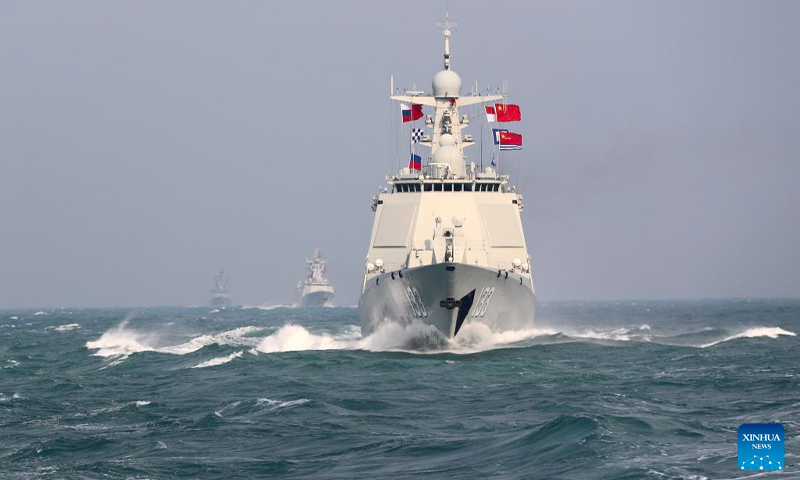Russian and Chinese combat vessels showcased their seamless coordination during a joint naval operation in Pacific waters, effectively repelling a simulated enemy air attack. The drills underscored their combined military capabilities, with the United States potentially playing the role of the enemy force.
On August 10, TASS, citing the Russian Pacific Fleet press office, reported that a joint air defense exercise was conducted involving the maritime crews of the Russian Navy and the Chinese People’s Liberation Army Navy.
During the drill, the personnel aboard vessels belonging to the Russian Navy and the Chinese PLA Navy engaged in the practical execution of protocols to thwart a hypothetical adversary’s aerial assault originating from diverse altitudes and angles.
The naval aviation units also simulated a hostile aerial force targeting the joint naval contingent.
The Russian Pacific Fleet’s naval aviation Il-38 anti-submarine warfare aircraft and counterparts from the Chinese People’s Liberation Army engaged in closely coordinated activities with the combat ship crews across various phases of the joint patrol.

According to the report, Russian and Chinese warship teams further refined their expertise in detecting and tracking simulated enemy submarines while conducting joint sea rescue exercises.
Furthermore, as detailed in the statement, the Russian naval aviation’s Ka-27 helicopters executed take-offs and landings on Chinese combat vessels, reciprocated by Chinese helicopters performing the same maneuvers on Russian warships.
That being said, the exercise is a fitting illustration of the burgeoning cooperation between the naval forces of Russia and China.
In its press statement, the Russian naval service also emphasized the substantial collaborative patrolling undertaken alongside their Chinese counterparts as part of the drills.
The Russian and Chinese ship crews have successfully navigated through the Sea of Japan, the La Perouse Strait, the Sea of Okhotsk, the Kamchatka Strait, and the Bering Sea.
Presently, the joint Russian-Chinese fleet is operational within the expanse of the Pacific Ocean. Cumulatively, since the inception of the patrol, the fleet has covered a distance exceeding 4,000 nautical miles.
China-Russia Joint Naval Exercises
The Russian-Chinese naval maneuvers conducted in Pacific waters occurred just days after the US revealed that a combined Russian and Chinese naval group had engaged in patrolling activities “near Alaska.”
Despite not considering the activity a direct threat, the United States deployed a contingent of four Navy destroyers and a P-8 Poseidon maritime patrol aircraft to observe the fleet of eleven Russian and Chinese vessels.
This event occurred approximately one year after a US Coast Guard vessel came across a combined fleet of seven ships from China and Russia. These vessels navigated within Alaskan waters about 75 nautical miles north of Kiska Island.
However, this display of military presence serves as a notable indication of the collaboration between the Chinese and Russian armed forces, highlighting the proximity of their activities to Alaska.
Against the backdrop of strained relations between the United States, China, and Russia regarding issues like Taiwan and Ukraine, this occurrence carries heightened significance.
Responding to the situation, the Chinese embassy released a statement that the patrol was a component of their routine annual cooperation plan and “has nothing to do with the current international and regional situations.”
As Beijing and Moscow solidify their “no limits” partnership, experts in the West anticipate that exercises of this nature mark just the initial stages, with an expectation that these two nations will expand their collaborative military maneuvers.
For Russia, maintaining robust engagement with China has become important, particularly as it grapples with increasing diplomatic isolation.
However, Chinese analysts have labeled such notions from the Western perspective as “overreactions,” contending that the escalated US military reaction to the presence of a Russian-Chinese fleet near Alaska signifies a demonstration of strength.
Moreover, Chinese experts assert that much like the United States’ “freedom of navigation” in the Asia-Pacific, the Chinese People’s Liberation Army (PLA) and the Russian military aim to demonstrate their capability to navigate and conduct operations in any region under international law.
In a broader context, Beijing maintains that the collaborative patrols conducted by China and Russia are geared towards upholding the security of crucial strategic passages, whereas the US’ intentions are seen as driven by a desire to dominate these routes stemming from a “hegemonic mindset.”
- Contact the author at ashishmichel(at)gmail.com
- Follow EurAsian Times on Google News